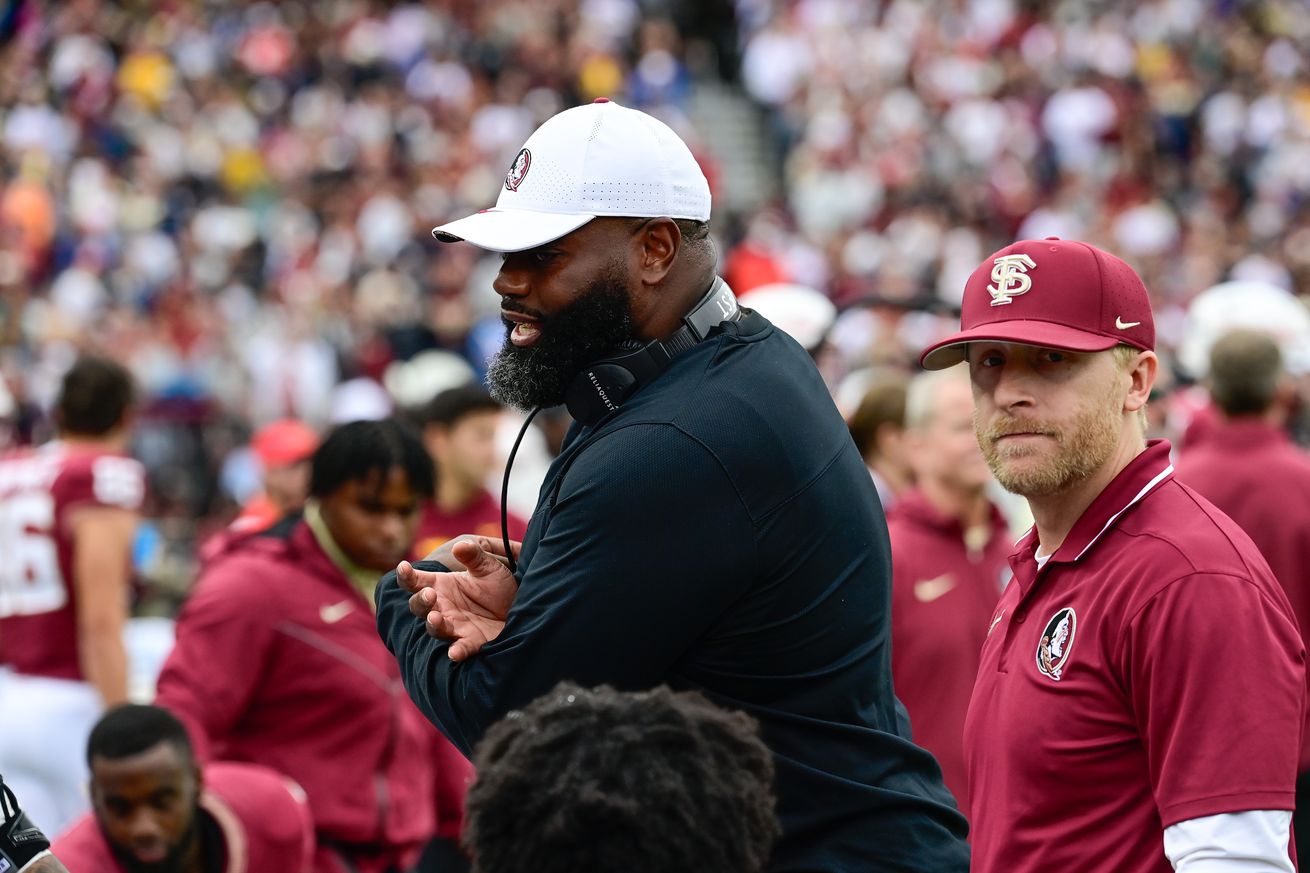
LSU’s new run game coordinator is here to perfect one play
How Did We Get Here?
The LSU run game was a season-defining failure a year ago. It was not the over-discussed Nussmeier turnovers, it wasn’t even the lack of addition to the roster last offseason, it was none of that. Sure those things didn’t help much, and they were never gonna win a National Title, but LSU missed the new 12-team playoff mainly for 1 reason.
THEY COULD NOT RUN THE FOOTBALL.
In this game, nothing exists in a vacuum. To put it in simpler terms, your fastball could be really, really good, but it loses effectiveness if that’s your only good pitch. LSU’s dropback pass game was fine, very good even, borderline great, but their inability to keep defenses honest and punish light boxes with an even serviceable run game ate into it. As we discussed after the loss to Florida, teams sold out and canceled space in the passing game because LSU couldn’t tie bodies to the box.
— MTFilmClips (@MTFilm) November 18, 2024
— MTFilmClips (@MTFilm) November 18, 2024
Defenses could keep safeties deep and drive on everything shallow and in the intermediate from depth. At a certain point, it just becomes impossible to live that way, and the QB that LSU put everything on started to press a little bit because he frankly had to.
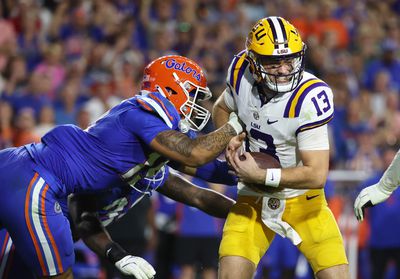
Kim Klement Neitzel-Imagn Images
Going into the season LSU actually had a good plan for their run game….in theory. They knew how their offense was built, what they needed from the rushing attack, and how to marry it to their fastball which was the gun dropback pass game. Because the aim was to punish light boxes, get downhill, and do everything from shotgun, building everything around counter as a base run scheme was a good idea for LSU.
— MTFilmClips (@MTFilm) March 24, 2025
They just could not get it right, and everything unraveled from there. They haven’t abandoned the idea. This offseason, they made the quiet move to hire former Florida State OL Coach/OC Alex Atkins for TEs/Run Game Coordinator. This tells me a couple of things very clearly.
- They know exactly where they went wrong
- They know exactly who can fix it
Whatever you may want to say about the program-wide disaster that was 2024 Florida State…..Alex Atkins is one of the game’s foremost masters of one particular thing.
The Fundamentals of Counter
Not only have we discussed this play in-depth together before, I’ve already broken down Atkins to an extent. As a result, I highly highly recommend you go reread my preview of 2023’s season opener against Florida State, in which I touched on everything you generally need to understand from a fundamental standpoint about counter, on both sides of the ball.
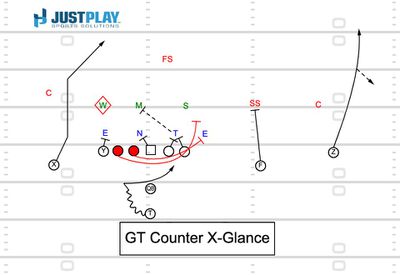
Because some of you will not want homework, the basic foundation of the play is that the frontside of the line will block down away from the direction of the run and 2 pullers from the backside will pull around to lead for the RB.
— MTFilmClips (@MTFilm) March 23, 2025
From there, there are tons of different configurations and variations of how you can shape it to deal with/attack different things, but at the root, there will always be down blocks and 2 pullers.
Defending Counter
Loaded Boxes
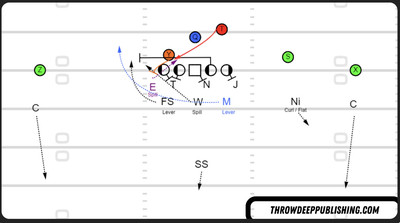
To understand how it will be tagged and adjusted by the O, we have to understand the basics of how it’s defended. Because pulling linemen move along the LOS, 2nd level defenders have to move with them. The idea defensively is to get 3 defenders to the ball to outnumber the 2 pullers. As we saw above, the first 2 defenders will engage the 2 pullers, but where the 3rd guy comes from determines whether they’ll “box” by taking the outside shoulders of the pullers and forcing the RB back inside or “spill” by taking the inside shoulders and forcing him wide.
— MTFilmClips (@MTFilm) March 24, 2025
— MTFilmClips (@MTFilm) March 24, 2025
Because of the pullers, it’s not necessarily a “sound” run and if the defense loads the box, it’s generally easy for them to get the numbers they need to have one more guy than the O can block.
Light Boxes
— MTFilmClips (@MTFilm) March 24, 2025
When defenses want to keep both safeties deep though as they do against teams with scary passing games, and frankly do in general, it becomes very difficult to defend, and the pullers make it one of the best schemes for explosive runs. In combination, it’s one of the best answers in the game to light boxes that OCs have, which is why it is such a favorite of spread coordinators like Lincoln Riley.
What LSU Tried, How It Went Wrong
— MTFilmClips (@MTFilm) March 26, 2025
As we talked about earlier, LSU planned on using counter to gash empty boxes when teams committed resources to the intermediate and vertical passing game that the offense is built around. In theory, with a talented and physical OL that almost won the Joe Moore Award the year prior, they’d have the power on the line of scrimmage to destroy 2-high defenses physically. The problem though, and this dates back to when Mike Denbrock was still here so it’s not new, is that they never knew how to properly run the play. Run games are like restaurants, the only way to do something right is to have an identity and kitchen personnel that know it inside and out. You must have a seasoned ability to teach specific techniques, construct rules for different fronts, pressures, and situations, understand the problem areas, and understand how to choreograph the blocking so that it’s shaped exactly right. You have a fastball run scheme or family, build layers around that, have as many answers as possible, and then you have a couple other run schemes like duo as changeups.
— MTFilmClips (@MTFilm) March 26, 2025
How good your rules and fundamentals are will determine everything about how consistently well you execute a run play, and LSU’s rules on counter were abysmal. There were bad combo and climb declarations, limited adaptability to different fronts and pressures, bad technique, everything was bad.
— MTFilmClips (@MTFilm) March 26, 2025
The most pervasive issue was their handling of exchanges and spills. When the edge defender knifes inside to spill the ball outside, the 2nd puller is supposed to wrap around outside and lead to the perimeter. This allowed defenses to just spill the ball to free defenders and force the RB to work back inside into congestion after trying to bounce. You want to have your 2nd puller adjust to that so he’s still there to take the 2nd defender.
— MTFilmClips (@MTFilm) March 26, 2025
Like so. It killed a lot of plays for LSU when the 2nd puller would try to lead through the middle like they would normally instead of adjusting. They’d just jam into the first puller and the 2nd guy would be free to make the tackle. There were many other common mistakes, but this was the biggest one. These things need to be drilled and perfected.
Alex Atkins, THE Counter Guy
— MTFilmClips (@MTFilm) April 8, 2025
Alex Atkins at Florida State was one of the nation’s foremost counter run-game architects. He’s an accomplished OL coach and run game designer, and teaches gap scheme technique at a very high level. You can see in this one clip everything LSU wasn’t doing a year ago. On the frontside, you see the pullers handle the spill and exchange, the guard getting good leverage and movement on the nose with good combination help from the RT, and you see the RT get proper verticality at a good angle to cut off the mike from overlapping. Backside, the LT and LG handle the backside end and the slant from the 3 technique with good area principles to avoid penetration, and the backs know how to read it. It’s crisp and well-shaped, it’s all there.
Building a System
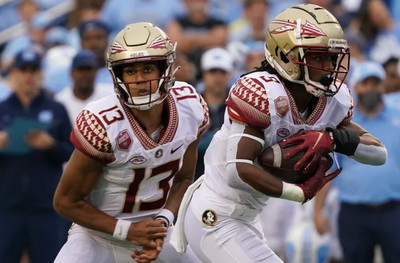
A base play is not enough, and any good identity-based run game is going to have a world of constraints based on that play. You figure out how defenses respond and punish it, often within the confines of the same base concept, but also with different run plays, play-action passes, and boots.
— MTFilmClips (@MTFilm) April 8, 2025
They’re creative with adjustments. For instance here with two 3 techniques instead of a nose and a 3 technique, they switch the puller from the backside G to the C. Instead of having the C block all the way down two whole bodies over, they have the G stay to take that guy and pull the C who is uncovered. Often with counter you can leave the backside end unblocked, especially if your QB can run like Jordan Travis, though there are ways to do it with the RPO as well.
— MTFilmClips (@MTFilm) August 23, 2023
— MTFilmClips (@MTFilm) April 8, 2025
RPO tags are a key part of gap scheme run games, in-fact they’re the only downhill run games RPOs still work in because of the necessity of moving the 2nd level defenders to match the pullers. With inside zone, guys can stay where they are and be in the windows but pullers move and if they don’t go follow them, the offense has them hopelessly outnumbered where the ball will hit. As a result, there’s a lot of conflict created especially if you’re not going to involve the safety in the box as you see in the second clip. That brings us to why this is so good for a pass-first LSU team. If you’re gonna keep both safeties deep, they can rig the numbers in the box and put your second-level defenders into conflict.
As long as you can create light boxes with your passing game (or have a QB who can run), you can do so much with counter, both in how you tag it and what you do off of it pic.twitter.com/M0B0MipuDf
— Max Toscano (@maxtoscano1) April 8, 2025
It’s a play that you can layer in a million different ways because of that conflict you can create. Depending on which defender you want to put in a bind, there are a slew of blocking tags, QB run reads, and RPO concepts available to you. The displacement also works well when you call designed action passes off of it, as you can use the pullers those guys to clear windows in strategic ways even if they’re just pass-protecting rather than run-blocking.
The Final Piece?
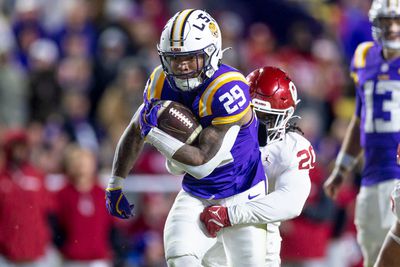
Stephen Lew-Imagn Images
If LSU can get this right, everything else falls into place. While that’s still a big if with the heavy levels of OL turnover losing 4 starters, they’ve made a big hire to do it. LSU has the best returning QB in the country in my opinion and new vertical threats on the outside to go with an elite intermediate threat in Aaron Anderson. LSU only needs a functional run game, to be efficient against light boxes to satisfy their schematic demands and punish defenses, but if it’s blocked effectively they have the talent at RB with Durham and freshman Harlem Berry to make any space extremely dangerous and turn efficiency into explosiveness. It also helps Nussmeier, as he doesn’t have to drag the offense through unfavorable situations and in the worst of times, press beyond safety to create any offense. With the creativity and soundness on Atkins’ resume, they’ve made a targeted move to put that into place.